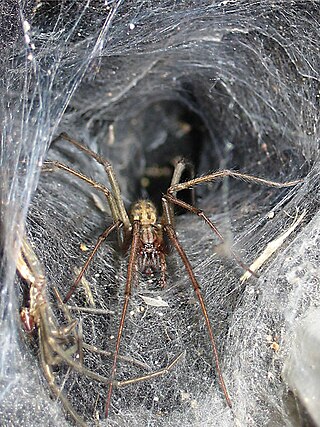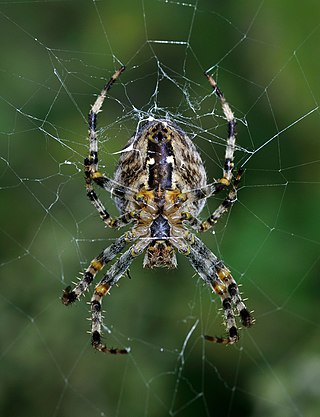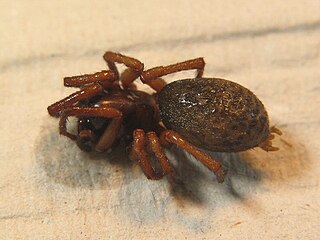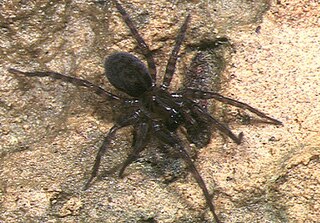
The hobo spider is a member of the family of spiders known colloquially as funnel web spiders, but not to be confused with the Australian funnel-web spider. Individuals construct a funnel-shaped structure of silk sheeting and lie in wait at the small end of the funnel for prey insects to blunder onto their webs. Hobo spiders sometimes build their webs in or around human habitations. The hobo spider lays its eggs in September and they hatch during late spring. After the male hobo spider mates it dies.

The Agelenidae are a large family of spiders in the suborder Araneomorphae. Well-known examples include the common "grass spiders" of the genus Agelenopsis. Nearly all Agelenidae are harmless to humans, but the bite of the hobo spider may be medically significant, and some evidence suggests it might cause necrotic lesions, but the matter remains subject to debate. The most widely accepted common name for members of the family is funnel weaver.

Amaurobiidae is a family of three-clawed cribellate or ecribellate spiders found in crevices and hollows or under stones where they build retreats, and are often collected in pitfall traps. Unlidded burrows are sometimes quite obvious in crusty, loamy soil. They are difficult to distinguish from related spiders in other families, especially Agelenidae, Desidae and Amphinectidae. Their intra- and interfamilial relationships are contentious. According to the World Spider Catalog, 2023, the family Amaurobiidae includes 286 species in 50 genera.

The giant house spider has been treated as either one species, under the name Eratigena atrica, or as three species, E. atrica, E. duellica and E. saeva. As of April 2020, the three species view was accepted by the World Spider Catalog. They are among the largest spiders of Central and Northern Europe. They were previously placed in the genus Tegenaria. In 2013, they were moved to the new genus Eratigena as the single species Eratigena atrica. In 2018, the three separate species were restored. The bite of these species does not pose a threat to humans or pets, and they are generally reluctant to bite, preferring instead to hide or escape.

The Agelenoidea or agelenoids are a superfamily or informal group of entelegyne araneomorph spiders. Phylogenetic studies since 2000 have not consistently recovered such a group, with more recent studies rejecting it.

The Entelegynae or entelegynes are a subgroup of araneomorph spiders, the largest of the two main groups into which the araneomorphs were traditionally divided. Females have a genital plate (epigynum) and a "flow through" fertilization system; males have complex palpal bulbs. Molecular phylogenetic studies have supported the monophyly of Entelegynae.
Tonsilla is a genus of East Asian funnel weavers first described by J. F. Wang & C. M. Yin in 1992.

Pireneitega is a genus of funnel weavers first described by Kyukichi Kishida in 1955.

Inermocoelotes is a genus of funnel weavers that was first described by S. V. Ovtchinnikov in 1999.

Allagelena gracilens is a spider species found in Europe and eastward to Central Asia.

Allagelena is a genus of Asian funnel weavers first described by Z. S. Zhang, Ming-Sheng Zhu & D. X. Song in 2006.
Ageleradix is a genus of East Asian funnel weavers first described by Xu & Li in 2007.

Iwogumoa is a genus of Asian funnel weavers first described by Kyukichi Kishida in 1955.
Notiocoelotes is a genus of spiders in the family Agelenidae. It was first described in 2008 by Wang, Xu & Li. As of 2017, it contains 13 Asian species.
Sinocoelotes is a genus of spiders in the family Agelenidae. It was first described in 2016 by Zhao & Li. As of 2017, it contains 15 species from China and Thailand.
Troglocoelotes is a genus of east Asian funnel weavers. It was first described by B. Li, Z. Zhao and C. T. Zhang in 2019, and it has only been found in China.
Hengconarius is a genus of funnel weavers first described by Zhao & S. Q. Li in 2018.
Griseidraconarius is a genus of east Asian funnel weavers. It was first described by K. Okumura in 2020, and it has only been found in Japan. As of November 2021 it contains only three species: G. akakinaensis, G. decolor, and G. iriei.










